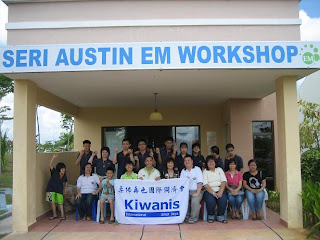With all the food, garbage, and water, restaurants are notorious for attracting pests. Therefore, cleanliness is extremely important. Also, restaurants care about keeping chemicals away from the foods they plan to prepare for their customers. What better way is there than to get rid of the chemicals and clean with all natural products?
The Grease Trap:Extending the time between cleanouts of the trap and drains will save the restaurants several hundred dollars per cleanout. EM-1® will digest the majority of the grease and stabilize proteins (something no other product on the market can currently claim.) This will control odors and keep the trap from backing up.
Regular applications of Effective Microorganisms™ brand products (EM-1®) will keep the restaurant pest and grease free, leaving the restaurant owner with a secure feeling, knowing there will be no grease trap overflows or health department problems.
The Hood, Behind, and Underneath The Line:
There are a couple of easy ways to apply a solution of EM-1® to these areas during breakdown. One is to use a pump sprayer and spray in a fine mist each time you breakdown or cleaning. Another way is to use a spray bottle and spray the solution directly on the surface at the end of each shift. Within a short time, the grease will be eaten off the wall and you will only need to polish the surface. A Great Time Saver!
General Cleaning During Breakdown:
Using EM-1® during the nightly wash down (breakdown) on the line and the firewall behind is great for fire preventive. The EM-1® eats the grease on the walls, the stoves, and the hood and gets rid of the fire hazard by eating the grease.Moping The Floor (Tile, Stone, and Wood):
Add a combination of water and EM-1® to the mop bucket. You won't need any soap, bleach, or grease cutter any more. The floor will not have that haze of grease. This will be great because it will prevent the slick slipping hazard that is almost impossible to get rid of with normal cleaners.
Use a sprayer and spray a solution of water and EM-1® onto the carpet after each dining time. Since carpets harbor odors, this will help to stop the odor, build up of grease, and stop matting of the carpet fibers. This will leave the room smelling and looking fresh every day.
When steam cleaning the carpets, add a cup of EM-1® for each full reservoir of water.
Odor (Smoke, Food, Grease, etc):
Regular use of EM-1® inside the restaurant will stop odors in the sewer or septic lines that hover around the manholes that your walk by on their way into your restaurant.
Spraying the dining area (the front of the house) with a mixture of Effective Microorganisms™ (EM-1®) and water will keep grease down on the carpeted areas and eat any odors from dirt, spilled alcohol, and smoke.
All the mats should be hosed down with a solution of EM-1® during normal cleaning as well. This will not only keep odors from coming out of the mats, but will also eat the grease on the makes, keeping them from being so slippery.
EM-1® can be put into an evaporative cooler or in Smoke-Eater® filters to get rid of the smells in the air. EM-1® in air conditioner and "swamp cooler" keeps the components and filters clean and running efficiently. This can be done by using a simple siphon unit connected to a container of EM-1®.
Cleaning the bathrooms with an Effective Microorganisms™ (EM-1®) solution will get rid of all smells of urine and drain back gassing.The recommended dilution rates for typical food service establishment and industry applications are as follows:
| Dilution Rate | Purpose | Quantity | Application |
|
| Odors & Tobacco Smoke | Slightly Moist | Daily |
|
| Dumpsters | Wet |
|
| 1: 10 | Garbage Disposal |
|
|
|
| Kitchen Floor Drains | 1-2 ounces per Drain | Daily at closing |
|
| Floor Drains |
|
|
|
| Food Waste Container | Final Rinse |
|
| 1:20 | Carpets & Mats | Slightly Moist | 1-2 times per week |
|
| Kitchen sinks, Dishwashers, and all non-food prep areas | Appropriate Amount | 1-2 times per week |
|
| Bathroom fixtures/floors | Final Rinse/Mopping |
|
| 1:50 | Urinals | 1-2 ounces per drain | Daily at closing |
|
| Metal Stall Base* | Wet Spray |
|
| 1:1:100** | Floors | 1/4-3/4 cup per bucket | **Hot water final mop |
*Stops rusting of metal surfaces by eliminating free radicals and oxidation.
**{EM-1®: Vinegar: Hot Water} Each night use mild non-antibacterial soap and 5% acid white vinegar to eliminate the grease film on the floor. For tougher application use 1:1:50.















































